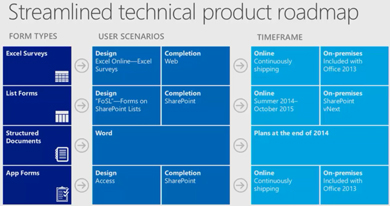Prepare Your InfoPath Strategy for a Smooth Transition
In January, Microsoft announced that there would be no further releases of InfoPath, with the current release supported through April 2023. As with every end-of-life announcement, customers and partners alike have to deal with the realities of product transitions.
A recent blog post entitled "Keep Calm and InfoPath On," authored by Jonathan Ralton, senior information architect at BlueMetal, clears up misconceptions and offers practical advice for partners to build an effective InfoPath strategy for their clients. I touched base with Ralton and Bob German, BlueMetal's principal architect, to talk about the options that partners have to help clients adapt to the eventual retirement of InfoPath.
"Since the definitive announcement, there has been a lot of panic, which is what I wanted to address in the blog post," Ralton explained. "People are thinking that InfoPath is coming to an immediate end and that they need to find an alternative solution immediately. That's just not the case."
"This is not like Windows XP, where you are at the end of the 10-year support window with the ticking time bomb of security issues," German said. "If you look at the strategy from Microsoft's point of view, they won't be too quick to pull back the InfoPath Forms Services [which supports Web-based forms]. They run the risk of building a barrier to upgrades and to move to Office 365. A lot of customers have large installed bases using Forms Services, so I suspect that they won't pull that until there is a migration path."
A Unified Voice
Internally, BlueMetal has been having conversations about its options, including stopping InfoPath development, looking at third-party ISV solutions as a replacement or moving to pure development. "As in most cases in consulting," Ralton noted, "the answer is, 'It depends.'"
"Customers are starting to bring it up so we need to be prepared for the conversations," German added. "We need to know how to handle our clients' situations, but perhaps more importantly, we need to provide a uniform message."
Both German and Ralton suggested that the bottom line for how partners approach solutions for individual customers should match their dependence on InfoPath. If the customer's use is minimal, the cost to replace the functionality with something different will likely be small. On the other hand, there are customers who have pushed InfoPath's functionality to the limit. Very complex forms created in InfoPath that support critical business processes need a well-thought plan.
For those customers and partners in the midst of InfoPath projects, Ralton reminds them that the business process analysis work is foundational. "The most important part of working with business process automation is mapping out the business process to streamline the workflow," Ralton said. "That time is not lost no matter what technology path you choose."
German believes that the end of InfoPath will affect partners differently. Partners who do not have in-house developers will either need to find a third-party package replacement or engage outside developers. Partners with development teams have more options through both third-party packages and custom-built solutions.
 [Click on image for larger view.]
InfoPath roadmap presented at the "Update on InfoPath and SharePoint Forms" SharePoint Conference session.
[Click on image for larger view.]
InfoPath roadmap presented at the "Update on InfoPath and SharePoint Forms" SharePoint Conference session.
This is the definitely the time for partners to start evaluating the third-partner solutions to be ready for the customer conversations. During the "Update on InfoPath and SharePoint Forms" session at Microsoft SharePoint Conference in March, four ISV partners were noted for their focus on the forms and work flow: K2, Nintex, Formotus and Qdabra.
"We don't know how long Microsoft will support Forms Services in their new releases," German noted. "The third parties, who do nothing but forms, are going to continue on and may be the safer bet. I expect that they will get quite a bit of business from this."
If nothing else, the announcement of InfoPath's end-of-life is a reminder that Microsoft is not standing still. That's a very good thing. The solutions that the channel supports will continue to evolve, opening new opportunities for the partners ready to help their customers adapt.
How are you managing your customer's InfoPath questions? Add a comment below or send me an e-mail and let's share your story.
Posted by Barb Levisay on May 07, 2014